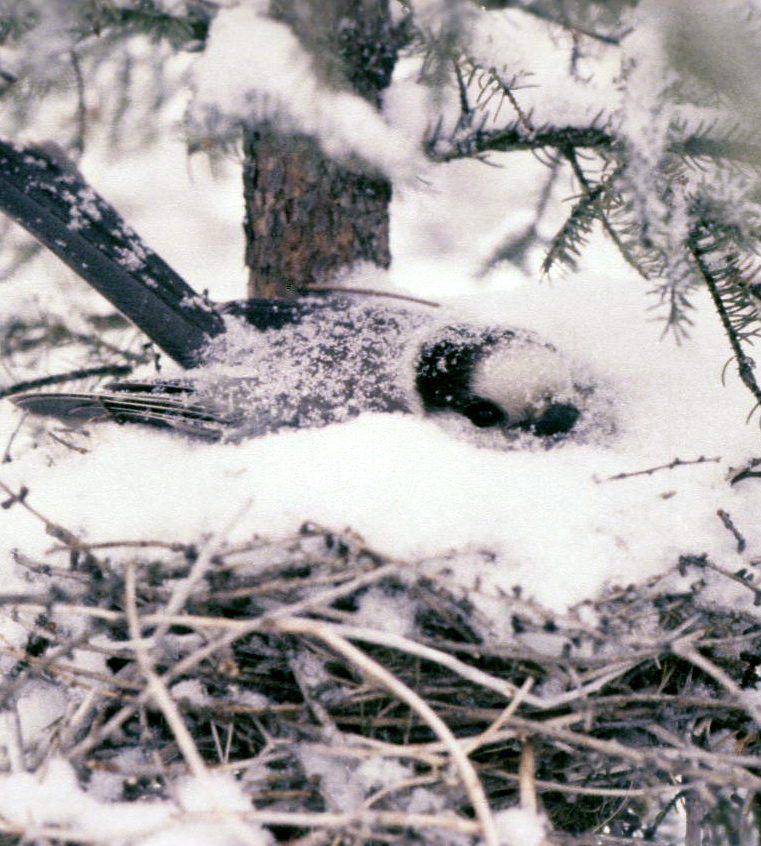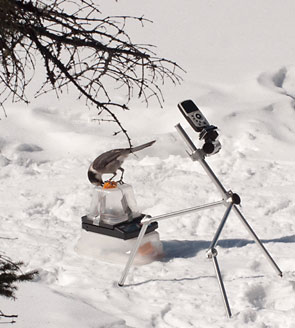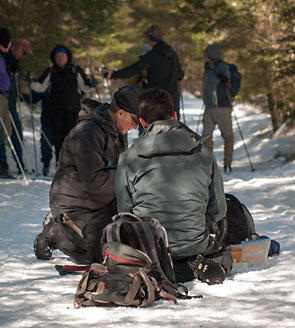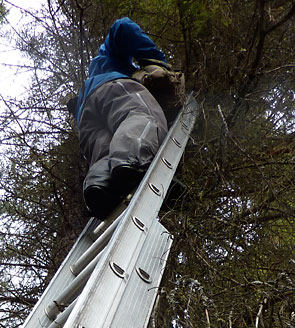Canada Jays are year-round residents of the boreal forest that rely on cached food for survival during the winter. Amazingly, Canada Jays (formerly Gray Jays) also begin breeding in late winter when little fresh food is available so adults also rely almost exclusively on cached food for reproduction. Since 2009, Ryan Norris and his graduate students have been collaborating with Dan Strickland, former Chief Park Naturalist for Algonquin Park, on Canada Jay research in Algonquin Park. Dan began marking Canada Jays in Algonquin and tracking their reproductive success in the mid 1970’s. For the past two decades, the Algonquin population of Canada Jays has declined by over 50% and we are currently examining hypotheses for the causes of this decline, including how long-term changes in climate may be influencing the quality and quantity of cached food. More recently, we are collaborating with biologists in Denali National Park, Alaska to examine the ecology of Canada Jays at the northern edge of their range. We have also started studying a marked population of Canada Jays on Mount Washington, Vancouver Island.
Canada Jay Publications
Fuirst, M, McLeod, J, & Norris, DR. 2022. Habitat preferences of adult Canada jays (Perisoreus canadensis) during the post-breeding period in Algonquin Provincial Park, Ontario. Canadian Journal of Zoology https://doi.org/10.1139/cjz-2021-0227.
Sorensen, MC, Strickland, D, Freeman, NE, Fuirst, M, Sutton, AO, & Norris, DR. 2022. Early-life experience shapes patterns of senescence in a food-caching passerine. Biology Letters 18: 20210532.
Quarrell, NJ, Strickland, D, & Norris, DR. 2022. Investigating factors that set the lower elevational limit of Canada Jays (Perisoreus canadensis) on Vancouver Island, British Columbia, Canada. Canadian Journal of Zoology 100(999): 64-76.
Fuirst, M, Strickland, D, & Norris, DR. 2021. Patterns and causes of breeding dispersal in a declining population of Canada jays, Perisoreus canadensis, over 55 years. Animal Behaviour 182: 31-41.
Fuirst, M, Strickland, D, & Norris, DR. 2021. Breeding dispersal in a resident boreal passerine can lead to short-and long-term fitness benefits. Ecosphere 12(9): e03747.
Freeman, NE, Norris, DR, Sutton, AO, Strickland, D & Newman, AEM. 2021. Early-life corticosterone and body condition influence social status and survival in Canada jays. Integrative and Comparative Biology 61(1):9-19.
Freeman, NE, Newman, AEM, Sutton, AO, Kyser TK & Norris, DR. 2021. Causes and consequences of variation in diet composition of nestling Canada Jays. Journal of Avian Biology 52(1): e02623.
Sutton, AO, Strickland, D, Freeman, NK & Norris, DR. 2021. Climate-driven carry-over effects negatively influence population growth in a food-caching boreal passerine. Global Change Biology 27(5): 983-992.
Sutton, AO, Strickland, D, Freeman, NK & Norris, DR. 2021. Environmental conditions modulate the compensatory effects of site-dependence in a food-caching passerine. Ecology 102(1): e03203.
Freeman, NK, Norris, DR, Sutton, AO & Newman AEM. 2020. Raising young with limited resources: supplementation improves body condition and advances fledging date of Canada Jays. Ecology 101(1): e02909.
Sutton, AO, Strickland, D, Freeman, NK, Newman, AEM & Norris, DR. 2019. Fall freeze-thaw events carry over to depress late-winter reproductive performance in Canada Jays. Royal Society, Open Science 6: 181754.
Derbyshire, R, Norris, DR, Hobson KA & Strickland, D. 2019. Isotopic spiking and food dye experiments provide evidence that Canada Jay nestlings receive cached food from their parents. Canadian Journal of Zoology 97: 368-375.
Whelan, S, Strickland, D, Morand-Ferron, J & Norris, DR. 2017. Reduced reproductive performance associated with warmer ambient temperatures during incubation in a winter-breeding, food-storing passerine. Ecology & Evolution 00:1-8.
Sutton, AO, Strickland, D & Norris, DR. 2016. Food storage in a changing world: implications of climate change for food-caching species. Climate Change Responses 3:12
Whelan, S, Strickland, D, Morand-Ferron, J & Norris, DR. 2016. Male experience buffers female laying date plasticity in a winter-breeding, food-storing passerine. Animal Behaviour 121: 61-70.
Derbyshire, R, Strickland, D & Norris, DR. 2015. Experimental evidence and 43 years of monitoring data support the food limitation hypothesis in a boreal food-caching songbird. Ecology 96: 3005-3015.
Strickland, D & Norris, DR. 2015. An example of phenotypic adherence to the island rule? – Anticosti gray jays are heavier but not structurally larger than mainland conspecifics. Ecology & Evolution 5:3687-3694.
Sechley, TH, Strickland, D & Norris, DR. 2015. Linking the availability of cached food to climate change: an experimental test of the hoard-rot hypothesis. Canadian Journal of Zoology 93: 411-419.
Sechley, TH, Strickland, D, Norris, DR. 2014. Causes and consequences of pre-laying weight gain in a food-caching bird that breeds in the late winter. Journal of Avian Biology 45: 85-93.
Norris, DR, Flockhart, DTT & Strickland, D. 2013. Contrasting patterns of survival and dispersal in multiple habitats reveals an ecological trap in a food-caching bird. Oecologia 173: 827-835.
Strickland, D, Kielstra, B & Norris, DR. 2011. Experimental evidence for a novel mechanism driving variation in habitat quality in a food-caching bird. Oecologia 167: 943-950.





